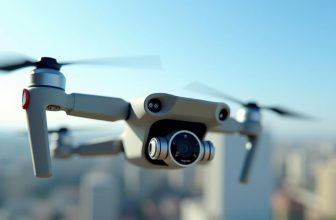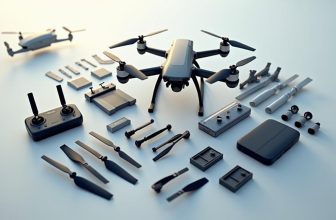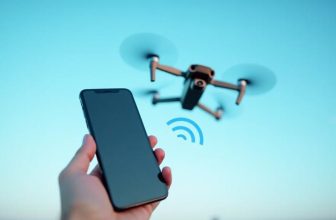
You're about to head out to fly your drone, but the skies are gray and rain is expected – can you still safely take to the air? It's a question that many drone enthusiasts face, and the answer isn't a simple yes or no. While some drones are designed to withstand a bit of moisture, flying in the rain can be hazardous if you're not prepared. In fact, water can damage your drone's electronics and put both your device and others at risk. But with the right precautions and knowledge, you might just be able to fly safely in the rain – but what are those precautions, exactly?
Contents
- 1 Key Takeaways
- 2 Drone Design and Water Resistance
- 3 Impact of Rain on Drone Performance
- 4 Risks of Flying in Heavy Rain
- 5 Drone Electronics and Moisture Damage
- 6 Waterproof Drone Models Available
- 7 Safety Precautions for Rainy Flights
- 8 Visibility and Weather Conditions
- 9 Drone Battery Performance in Rain
- 10 Post-Flight Maintenance and Care
- 11 Regulatory Guidelines for Rainy Flights
- 12 Frequently Asked Questions
- 13 Conclusion
Key Takeaways
- Properly designed and waterproofed drones with IP67 rating can withstand being submerged in water up to 1 meter for 30 minutes.
- Heavy rain reduces drone performance and visibility, increasing collision risk and damage to electronics.
- Regular inspection, maintenance, and drying after flight can minimize water damage and ensure optimal drone performance.
- Advanced sealing materials, hydrophobic coatings, and weather sealing protect drone electronics and internal components from water ingress.
- Drones should not be flown in heavy rain or standing water to prevent water ingress and damage to internal components.
Drone Design and Water Resistance
When designing a drone to fly in the rain, manufacturers consider various factors to guarantee it can withstand exposure to water.
You should be aware that a waterproof drone design is vital in ensuring the device's reliability and longevity. To achieve this, manufacturers use advanced sealing materials that prevent water from entering the drone's internal components.
These sealing materials are carefully selected to provide a reliable barrier against water and moisture.
The drone's design also incorporates water repulsion techniques to minimize the impact of rain on its exterior.
This includes applying hydrophobic coatings to the drone's surface, which helps to reduce the amount of water that comes into contact with the device.
Additionally, the drone's shape and aerodynamics are designed to allow water to run off easily, reducing the risk of water accumulation.
Impact of Rain on Drone Performance
When flying a drone in the rain, you'll notice a decrease in performance due to the impact of water on the drone's motor, electronics, and propellers.
Moisture can cause your drone's motors to work harder, which increases the risk of overheating and reduces their overall lifespan. Additionally, water can seep into the drone's electronics, causing damage, and also lead to a loss of propeller efficiency due to the added weight of water droplets.
Drone Motor Performance
Drone motor performance is a crucial aspect of flight in rainy conditions, as water and electronics don't mix well.
When flying a drone in the rain, you should ponder how the weather might affect your drone's motor dynamics. Motor performance can be impacted by the rain, which can alter the motor's efficiency, reliability, and overall lifespan.
Weather testing has shown that drone motors can be affected by rain in various ways.
Three key factors to ponder:
- Reduced Motor Efficiency: Rain can cause the motor to work harder, which can lead to reduced efficiency and increased heat generation.
- Increased Vibration: Water can seep into the motor's bearings, causing increased vibration and reduced motor performance.
- Corrosion and Wear: Rainwater can contain corrosive substances that can damage the motor's internal components, leading to premature wear and tear.
When flying a drone in the rain, you should be aware of these potential factors that can affect your drone's motor performance.
Understanding how rain can impact your drone's motor dynamics can help you make informed decisions about when and how to fly safely.
Electronic Component Damage
The electronics that power your drone are particularly vulnerable to rain, which can cause potentially catastrophic damage to the internal components.
Water ingress can short circuit the electronics and damage the circuit boards, rendering the drone inoperable. Furthermore, even if the drone is waterproof, humidity can still seep into the electronics compartment and cause damage over time.
To mitigate this risk, many drone manufacturers incorporate humidity protection measures into their designs.
These measures can include applying a hydrophobic coating to the electronics, sealing the compartment with a waterproof membrane, or using desiccants to absorb any moisture that may enter the compartment.
Additionally, corrosion prevention measures such as applying a protective coating to the metal components can help prevent damage from water and humidity.
When flying your drone in the rain, it's vital to check the manufacturer's recommendations for water resistance and take necessary precautions to safeguard the electronics.
Regularly inspecting and maintaining your drone can also help prevent water damage and guarantee peak performance.
It's also vital to avoid flying in heavy rain or standing water, as this can increase the risk of water ingress and damage to the electronics.
Propeller Efficiency Loss
Flying in the rain can compromise more than just your drone's electronics – it also affects its performance, particularly propeller efficiency.
When rain comes into contact with your drone's propellers, it can alter the propeller aerodynamics and airflow patterns, resulting in reduced efficiency.
This loss of efficiency can lead to decreased flight time, maneuverability, and overall performance.
Three key ways rain affects propeller efficiency:
- Weight gain Rain can accumulate on the propeller blades, adding weight and increasing the load on the motors. This can cause a decrease in propeller RPM and overall efficiency.
- *Airflow disruption*: Rain can disrupt the airflow patterns around the propeller blades, causing turbulence and reducing the propeller's ability to produce lift and thrust.
- *Viscosity increase*: Rain can increase the viscosity of the air, making it more difficult for the propeller blades to cut through. This can result in reduced propeller efficiency and increased motor load.
As you fly your drone in the rain, be aware of these effects and adjust your flight plan accordingly to guarantee safe and efficient operation.
Risks of Flying in Heavy Rain
When you fly a drone in heavy rain, you're exposing it to significant risks that can compromise its performance and longevity.
Reduced visibility due to heavy rain and decreased drone lighting can increase the likelihood of collision with obstacles, posing hazards to people and property.
Additionally, water ingress can damage the drone's electronics, leading to costly repairs or even complete system failure.
Reduced Visibility Hazards
Reduced Visibility Hazards
How does heavy rain affect your drone's visibility, and ultimately, your ability to navigate safely?
In rainy conditions, your drone's visibility is substantially reduced due to the rain's impact on the camera lens and the surrounding environment.
This can make it challenging to navigate safely and avoid obstacles.
To better understand the risks associated with reduced visibility, consider the following factors:
- Rain-induced fog: Heavy rain can create foggy situations, reducing your drone's visibility and making it harder to detect obstacles.
- Water droplets on the lens: Rain droplets on the camera lens can distort the image, further reducing visibility and making it challenging to navigate.
- Reduced light transmission: Rain can also reduce the amount of light transmitted to the camera, making it harder to see obstacles and navigate safely.
In such conditions, it's vital to exercise extreme caution and consider alternative options, such as delaying the flight or using instruments like radar or lidar to aid navigation.
Water Damage Risks
Water Damage Risks
In addition to reduced visibility, heavy rain poses a significant threat to your drone's internal components and overall integrity.
Water absorption is a vital concern when flying in the rain, as it can seep into the drone's body and damage electrical components. This can lead to short circuits, corrosion, and irreversible damage.
If you must fly in heavy rain, it's vital to take precautions to minimize water absorption.
One way to mitigate water damage is to apply hydrophobic coatings to your drone's body and components. These coatings repel water, reducing the risk of absorption and damage.
However, it's imperative to note that these coatings aren't foolproof and may not provide complete protection in extreme weather conditions.
To further minimize water damage risks, make certain that your drone is properly sealed and that all openings are covered or protected with water-repellent materials.
Regularly inspect your drone for signs of water damage and follow the manufacturer's guidelines for maintenance and repair.
Drone Electronics and Moisture Damage
Most drone electronics aren't designed to withstand prolonged exposure to moisture, which makes flying in the rain particularly hazardous for your drone.
Moisture can seep into the drone's internal components, causing corrosion, short circuits, and permanent damage.
When moisture enters your drone's electronics, it can lead to a range of issues, including:
- Corrosion of metal components: Moisture can cause metal parts to rust or corrode, leading to mechanical failures.
- Short circuits: Water can conduct electricity, causing short circuits that can damage your drone's electronics.
- Damage to sensitive components: Moisture can damage sensitive components such as sensors, cameras, and flight control systems.
To mitigate these risks, some drone manufacturers apply moisture barriers or waterproof coatings to their electronics.
These coatings can help protect your drone's internal components from moisture, but they aren't foolproof.
Crucial to keep in mind is that even with these protections, flying in the rain can still pose significant risks to your drone.
If you do decide to fly in the rain, make sure to take necessary precautions to minimize the risks of moisture damage.
Waterproof Drone Models Available
If you're regularly flying in wet conditions, investing in a waterproof drone model can substantially reduce the risk of moisture damage.
Waterproof drones are designed with specialized materials and weather sealing that prevent water from entering the internal compartments. Drone materials such as plastic, aluminum, and carbon fiber are often treated with water-resistant coatings or membranes to prevent moisture absorption.
Weather sealing is achieved through the use of rubber gaskets, O-rings, and other seals that protect the drone's electrical components from water ingress.
When shopping for a waterproof drone, look for models with IP ratings that indicate their level of water resistance.
For example, a drone with an IP67 rating can withstand being submerged in water up to 1 meter for 30 minutes.
Some popular waterproof drone models include the DJI Matrice 210 RTK, the Yuneec Typhoon H Pro, and the Swellpro Splash Drone 3+.
These drones are designed for use in harsh environments and can withstand exposure to rain, snow, and even complete submersion in water.
Safety Precautions for Rainy Flights
When flying a drone in rainy conditions, you'll need to take extra precautions to guarantee a safe and successful flight.
Establishing rainy protocols prior to takeoff can substantially reduce the risk of accidents and damage to the drone. Understanding the flight restrictions and capabilities of your drone in wet conditions is vital.
Before flying, verify that your drone is waterproof or water-resistant and that all components, including the propellers and battery, are securely attached.
Additionally, weigh the weight and aerodynamics of the drone, as rain can affect its flight performance.
Some key safety precautions to ponder:
- Monitor weather forecasts: Check the weather forecast before flying and be prepared to land your drone quickly if the rain becomes too heavy.
- Reduce flight altitude and speed: Lower altitudes and slower speeds can help reduce the impact of wind and rain on the drone.
- Keep a safe distance from water: Avoid flying over bodies of water or areas with standing water to minimize the risk of electrical short circuits.
Visibility and Weather Conditions
When flying a drone in the rain, you'll encounter reduced visual range due to water droplets on the camera lens and decreased light transmission through the atmosphere.
Heavy rainfall can further impact your flight by reducing visibility, making it difficult to track your drone's position and orientation.
Additionally, you'll need to weigh the effects of wind speed, as strong gusts can make it challenging to maintain control and navigate through the air.
Reduced Visual Range
Flying a drone in the rain substantially reduces your visual range due to decreased visibility.
The rain creates a cloudy atmosphere and foggy conditions, making it more challenging to navigate your drone safely. As a pilot, it's vital to evaluate the weather conditions before flying and ponder the potential risks associated with reduced visibility.
Three key factors to ponder when evaluating reduced visual range:
- Cloud Base: If the cloud base is low, it can greatly diminish your visual range, making it difficult to maintain line of sight with your drone.
- Fog Density: Thick fog can completely obscure your view, while lighter fog can create a challenging environment for navigation.
- Rain Intensity: Heavy rain can create a "whiteout" effect, making it impossible to see your drone, while lighter rain may only reduce visibility to a few hundred feet.
When flying in reduced visual range conditions, it's imperative to rely on your drone's instruments and sensors to maintain control and avoid obstacles.
Always follow local regulations and guidelines for flying in adverse weather conditions.
Heavy Rainfall Impact
Heavy rainfall has a profound impact on your drone's flight, substantially affecting visibility and weather conditions.
When you're planning to fly a drone in the rain, it's vital to ponder the intensity and pattern of the rainfall. Heavy rainfall can cause reduced visibility, making it challenging for you to maintain a visual line of sight with your drone.
Rainfall patterns, such as the direction and speed of the rain, can also impact your drone's flight.
To assess the conditions, you should check the weather forecasts before flying your drone.
Weather forecasts can provide you with information on the expected rainfall intensity, duration, and pattern. This information can help you make informed decisions about whether to fly your drone and how to adjust your flight plan accordingly.
It's also essential to monitor the weather conditions in real-time, as the rainfall pattern can change quickly.
By understanding the impact of heavy rainfall on your drone's flight, you can take necessary precautions to guarantee a safe and successful flight.
Always prioritize caution and safety when flying a drone in the rain.
Wind Speed Effects
Evaluating wind speed is a vital step in evaluating the overall safety of flying a drone in the rain.
Strong wind speeds can markedly impact your drone's stability and maneuverability, making it more challenging to control. When flying in the rain, you need to be aware of the wind speed and its effects on your drone.
Some key factors to take into account when evaluating wind speed effects are:
- Air currents and turbulence: Wind can create air currents and turbulence that can affect your drone's flight path. Be prepared for unexpected movements and adjust your drone's speed and direction accordingly.
- Gust patterns: Gust patterns can also impact your drone's stability. Be aware of sudden gusts of wind that can cause your drone to lose control or altitude.
- Drone design and weight: The design and weight of your drone can also affect its stability in windy conditions. Lighter drones may be more susceptible to wind effects, while heavier drones may be more stable.
Drone Battery Performance in Rain
When operating a drone in wet conditions, you're likely to notice a decline in its performance, particularly with regard to battery life.
Rain can affect drone batteries in several ways, primarily through water absorption. Water can infiltrate the battery compartment, causing corrosion or short circuits that reduce the battery's efficiency.
During rainy testing, it has been observed that drone batteries tend to lose power faster when exposed to moisture.
This is due to the increased internal resistance within the battery cells, which can lead to a higher discharge rate. Additionally, water absorption can cause the battery's electrolyte to break down, further reducing its overall capacity.
To minimize the impact of rain on drone battery performance, you must verify that the battery compartment is properly sealed and designed to prevent water ingress.
You should also closely monitor your drone's battery life during flights in wet conditions and plan your mission accordingly.
This may involve reducing flight times or carrying spare batteries to prevent unexpected power losses.
Post-Flight Maintenance and Care
After flying your drone in the rain, it's crucial to prioritize post-flight maintenance and care to prevent water damage and guarantee the longevity of your device.
To minimize the risk of damage, it's imperative to follow strict cleaning protocols and storage methods.
Post-Flight Procedures
To keep your drone in working condition, you should:
1. Dry the drone: Gently pat the drone's exterior with a soft cloth to remove any visible water droplets.
Pay attention to crevices and openings where water may have accumulated.
2. Clean electronic components: Use a soft-bristled brush or a cotton swab to gently remove any debris or water spots from the drone's electronic components.
3. Store in a dry environment: Store your drone in a well-ventilated area, away from direct sunlight and moisture.
Use a protective case or cover to shield the drone from dust and debris.
Regulatory Guidelines for Rainy Flights
Flying a drone in rainy conditions often raises concerns about compliance with regulatory guidelines.
You must understand that regulations regarding drone operations in adverse weather conditions vary by country and region.
In the United States, for example, the Federal Aviation Administration (FAA) requires drone operators to assess the weather conditions before flying and verifies they can maintain visual line-of-sight with the drone.
When flying in rainy conditions, vital awareness of flight restrictions in your area is necessary.
You should check with local authorities for any restrictions or guidelines specific to your location.
Additionally, you must also consider the drone's airworthiness and its ability to withstand rainy conditions.
Weather forecasting plays a pivotal role in planning safe drone flights.
You should monitor weather forecasts and warnings to anticipate potential rain showers or other adverse weather conditions.
Before flying in the rain, make certain you comply with relevant regulations and guidelines.
Review your drone's operating manual to understand its weather-related limitations and take necessary precautions to guarantee a safe flight.
Frequently Asked Questions
Can Drones Fly in Snow or Hail?
When flying drones in winter conditions, you should assess precipitation limits to guarantee safe operations. You must consider snow and hail's impact on sensors, propulsion, and structural integrity before conducting winter operations.
Do Rain Repellents Work on Drones?
You'll find that rain repellents like waterproof coatings and hydrophobic sprays can be effective on drone surfaces, decreasing water's surface tension and improving visibility, but they won't eliminate all risks associated with flying in rain.
Is Drone Insurance Valid in Rainy Conditions?
Like Odysseus charting unpredictable seas, you must check your drone insurance policy for weather exemptions and policy limitations. Typically, these policies don't cover damage from flying in rainy conditions, so review the fine print carefully.
Can Rain Cause Drone Propellers to Fail?
You risk propeller failure if water ingresses into the motor or bearings, causing corrosion. Water's weight and density can also disrupt airflow, leading to inefficiency and potential propeller failure due to excessive stress.
Do Waterproof Drones Require Special Maintenance?
You maintain your waterproof drone by inspecting the waterproof coating for damage and applying corrosion protection to metal components. Regularly cleaning and drying the drone also helps to prevent water spots and mineral deposits.
Conclusion
Flying a drone safely in the rain is achievable with the right design, precautions, and maintenance. According to the FAA, 70% of drone crashes occur due to operator error, often exacerbated by adverse weather conditions. By understanding drone design and water resistance, monitoring weather forecasts, and adhering to regulatory guidelines, you can minimize risks and guarantee a successful flight. Regular maintenance is also vital to prevent moisture damage and maintain peak performance.






